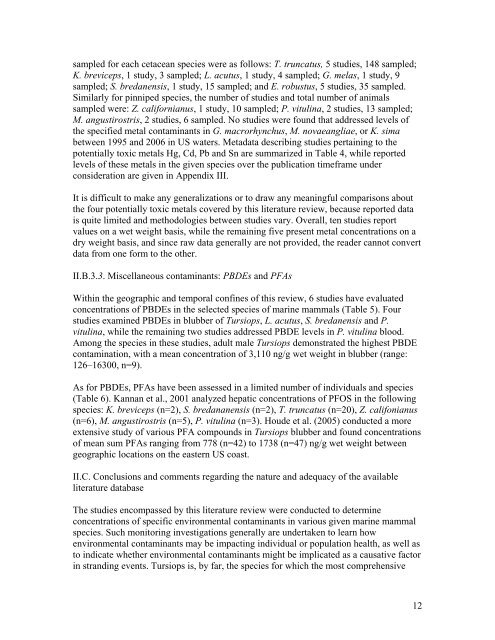Volume III, Appendices EM - National Marine Fisheries Service ...
Volume III, Appendices EM - National Marine Fisheries Service ...
Volume III, Appendices EM - National Marine Fisheries Service ...
Create successful ePaper yourself
Turn your PDF publications into a flip-book with our unique Google optimized e-Paper software.
sampled for each cetacean species were as follows: T. truncatus, 5 studies, 148 sampled;<br />
K. breviceps, 1 study, 3 sampled; L. acutus, 1 study, 4 sampled; G. melas, 1 study, 9<br />
sampled; S. bredanensis, 1 study, 15 sampled; and E. robustus, 5 studies, 35 sampled.<br />
Similarly for pinniped species, the number of studies and total number of animals<br />
sampled were: Z. californianus, 1 study, 10 sampled; P. vitulina, 2 studies, 13 sampled;<br />
M. angustirostris, 2 studies, 6 sampled. No studies were found that addressed levels of<br />
the specified metal contaminants in G. macrorhynchus, M. novaeangliae, or K. sima<br />
between 1995 and 2006 in US waters. Metadata describing studies pertaining to the<br />
potentially toxic metals Hg, Cd, Pb and Sn are summarized in Table 4, while reported<br />
levels of these metals in the given species over the publication timeframe under<br />
consideration are given in Appendix <strong>III</strong>.<br />
It is difficult to make any generalizations or to draw any meaningful comparisons about<br />
the four potentially toxic metals covered by this literature review, because reported data<br />
is quite limited and methodologies between studies vary. Overall, ten studies report<br />
values on a wet weight basis, while the remaining five present metal concentrations on a<br />
dry weight basis, and since raw data generally are not provided, the reader cannot convert<br />
data from one form to the other.<br />
II.B.3.3. Miscellaneous contaminants: PBDEs and PFAs<br />
Within the geographic and temporal confines of this review, 6 studies have evaluated<br />
concentrations of PBDEs in the selected species of marine mammals (Table 5). Four<br />
studies examined PBDEs in blubber of Tursiops, L. acutus, S. bredanensis and P.<br />
vitulina, while the remaining two studies addressed PBDE levels in P. vitulina blood.<br />
Among the species in these studies, adult male Tursiops demonstrated the highest PBDE<br />
contamination, with a mean concentration of 3,110 ng/g wet weight in blubber (range:<br />
126–16300, n=9).<br />
As for PBDEs, PFAs have been assessed in a limited number of individuals and species<br />
(Table 6). Kannan et al., 2001 analyzed hepatic concentrations of PFOS in the following<br />
species: K. breviceps (n=2), S. bredananensis (n=2), T. truncatus (n=20), Z. califonianus<br />
(n=6), M. angustirostris (n=5), P. vitulina (n=3). Houde et al. (2005) conducted a more<br />
extensive study of various PFA compounds in Tursiops blubber and found concentrations<br />
of mean sum PFAs ranging from 778 (n=42) to 1738 (n=47) ng/g wet weight between<br />
geographic locations on the eastern US coast.<br />
II.C. Conclusions and comments regarding the nature and adequacy of the available<br />
literature database<br />
The studies encompassed by this literature review were conducted to determine<br />
concentrations of specific environmental contaminants in various given marine mammal<br />
species. Such monitoring investigations generally are undertaken to learn how<br />
environmental contaminants may be impacting individual or population health, as well as<br />
to indicate whether environmental contaminants might be implicated as a causative factor<br />
in stranding events. Tursiops is, by far, the species for which the most comprehensive<br />
12
















